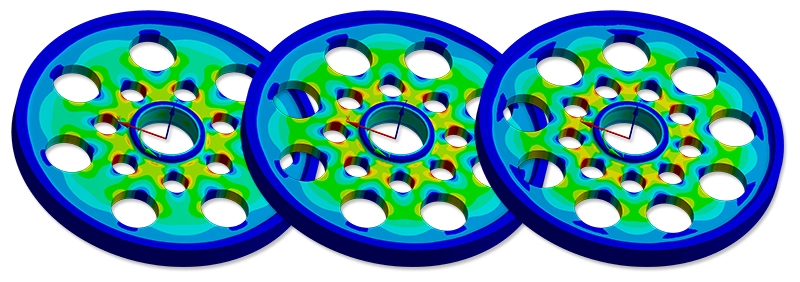Nowadays manufacturers must develop faster reliable and more durable products, which are lightweight and look elegant, and at a minimal cost. Quadco Engineering uses the most performant and advanced software tools to tackle any optimisation problem. With virtual simulations and analyses a remarkable decrease of the product development time can be achieved, because information of necessary design changes can be implemented more quickly.
Our extensive expertise in optimisation can help you to develop and market innovative and durable products in a competitive time frame.
Parametric optimisation with FEA
In numerical optimisation, many parameters can be used to influence the optimisation objective. Those parameters can be continuously variable within boundaries or variable only in predefined steps, as is for instance the case with commercially available plate thicknesses.
The input parameters can be of different types: geometrical parameters (from CAD geometry or FEA input), material properties, loads, constraints, etc. Output parameters can be the stiffness (deformations) or the strain and stress level.

Parametric optimisation with CFD
The optimisation process using CFD is similar to the process with FEA. It uses also geometrical input parameters from CAD, but because of different physics involved, other input parameters are velocity, pressure, temperature etc. More complex output parameters to be optimised can be e.g. the standard deviation of the pressure, velocity or temperature profile along the fluid domain.
Advanced optimisation tools
To further improve the performance of an optimisation procedure, additional tools such as Response Surfaces, Six Sigma and Direct Optimisation can be used to provide a deeper understanding of the optimisation potential in a design.
Evaluate many what-if scenarios with FEA and CFD
An important advantage of parametric optimisation is that numerous of what-if scenarios can be analysed to assess the sensitivity of an output variable (e.g. stiffness, strength, energy loss, etc.) to the change of one or more input variables. The number of required scenarios depend on the number and the value range of input parameters. When there are many input variables, the number of possible scenarios quickly become very large. Techniques as DOE can help to reduce the number of required scenarios, without compromising on quality.
Design Of Experiments or eliminating the number of scenarios
Design Of Experiments (DOE) is a technique used to scientifically determine values of a number of parameters. This method helps to reduce the number of different scenarios that needs to be analysed, but still covering the system response of all possible parameter combinations.
Various DOE algorithms are available, all with their own applications, strengths and weaknesses. The experts at Quadco Engineering can guide and support you in this rather complex domain.
Topology optimisation
What are the possibilities when you need an innovative approach to improve the design of an existing product? Or maybe you need to design a component that needs to fit in a confined space and must be equally lightweight and durable. When you only have a rough idea how a part should look like and there are, in other words, no geometrical parameters yet to optimise, then topology optimisation can most likely be a solution to further help you.
Topology optimisation solvers seek for the best material distribution throughout a component, bounded by a number of constraints, to achieve the optimisation objective. Topology optimisation usually starts with a solid block of material and takes away material that doesn't contribute much to the stiffness or strength of the component. Optimisation goals can be weight reduction, stiffness increase/decrease and strength improvement.
Topology optimisation often leads to very innovative and complex shapes. The obtained shapes lend themselves therefore mainly for casting or 3D printing processes.
Let our engineering team support your design process
The engineers at Quadco Engineering are experts in numerical optimisation and have long-standing experience in solving a wide range of parametric and topology optimisation challenges in different industries.
Quadco Engineering continue to invest in the latest simulation and analysis software and also develops in-house software to meet the needs of our clients. We focus on delivering detailed and comprehensive data to our customers, to allow for a quick implementation of the analysis results into our client's designs.
We are ready to optimise all your structural and fluid flow problems and to guide you in improving the performance of your products and processes.
Contact us today via contact for our offer or to set up a meeting to discuss your analysis challenges.